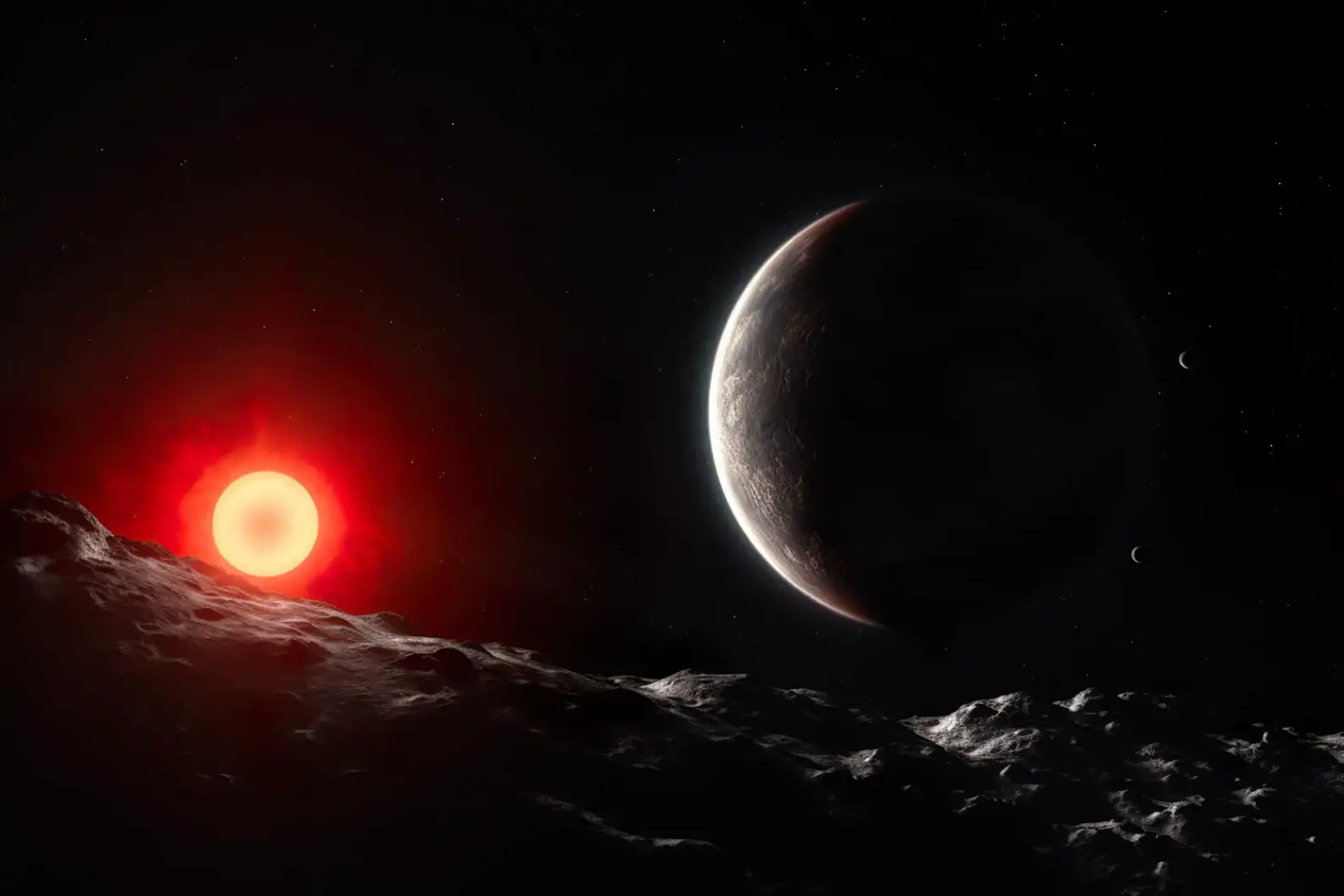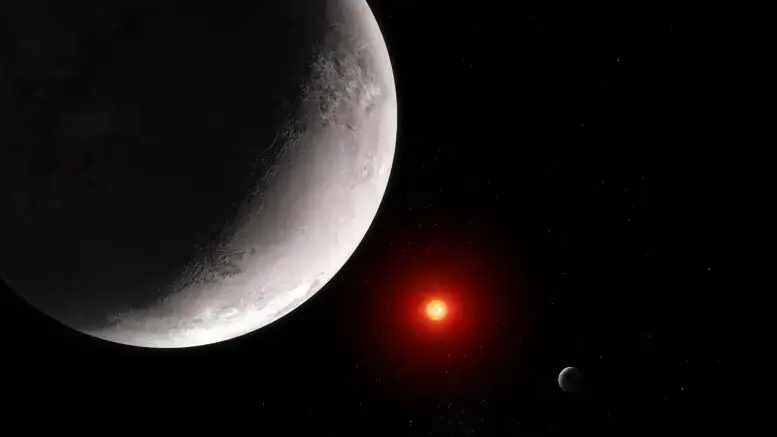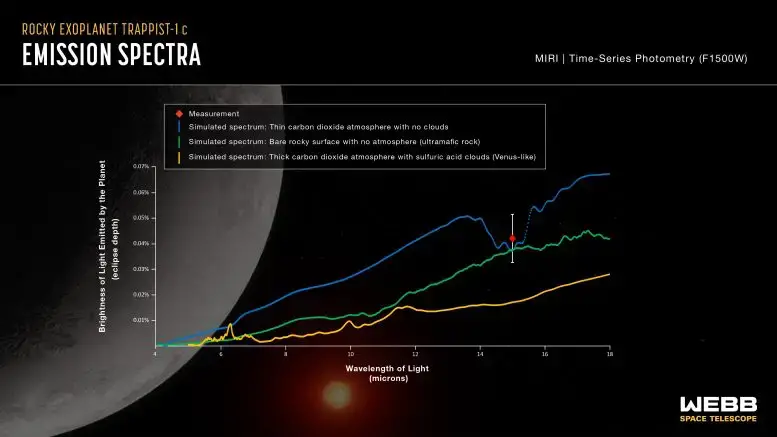NASA’s James Webb Space Telescope has discovered that exoplanet TRAPPIST-1 c, despite being the same size as Venus and receiving similar radiation, does not have a thick carbon dioxide atmosphere, making it unlikely to be a Venus analog. The planet, which has the coolest measured temperature for a rocky exoplanet, might have formed with minimal water content. It either lacks an atmosphere or possesses a very thin one, and further research will investigate temperature variations on the planet and continue studying potential atmospheric conditions.

Infrared measurements of TRAPPIST-1 c indicate that it is probably not as Venus-like as once imagined.
NASA’s James Webb Space Telescope has successfully measured the heat radiating from TRAPPIST-1 c, an exoplanet orbiting a red dwarf star 40 light-years from Earth. With a dayside temperature of about 225 degrees Fahrenheit, it is the coolest rocky planet ever characterized using this method.
Unfortunately for those hoping that the TRAPPIST-1 system is a true analog to our own, the results are a bit disappointing. While TRAPPIST-1 c is roughly the same size and mass as Venus and receives the same amount of radiation from its star, it appears unlikely to have the same thick carbon dioxide atmosphere. This indicates that the planet, and perhaps the system as a whole, may have formed with very little water. The result is the latest in the quest to determine whether planetary atmospheres can survive the violent environs of a red dwarf star.

This artist’s concept shows what the hot rocky exoplanet TRAPPIST-1 c could look like based on this work. TRAPPIST-1 c, the second of seven known planets in the TRAPPIST-1 system, orbits its star at a distance of 0.016 AU (about 1.5 million miles), completing one circuit in just 2.42 Earth-days. TRAPPIST-1 c is slightly larger than Earth, but has around the same density, which indicates that it must have a rocky composition. Webb’s measurement of 15-micron mid-infrared light emitted by TRAPPIST-1 c suggests that the planet has either a bare rocky surface or a very thin carbon dioxide atmosphere.Illustrated in the background is TRAPPIST-1 b, the innermost planet in the TRAPPIST-1 system. TRAPPIST-1 b is also rocky and appears to have no substantial atmosphere.The star, TRAPPIST-1, is an ultracool red dwarf (M dwarf) with a temperature of only 2,550 kelvins (about 4,150 degrees Fahrenheit) and a mass just 0.09 times the mass of the Sun.This illustration is based on new data gathered by Webb’s Mid-Infrared Instrument (MIRI) as well as previous observations from other ground- and space-based telescopes. Webb has not captured any images of the planet.Credit: NASA, ESA, CSA, Joseph Olmsted (STScI), Sebastian Zieba (MPI-A), Laura Kreidberg (MPI-A)
Webb Space Telescope Rules Out Thick Carbon Dioxide Atmosphere for Rocky Exoplanet
An international team of researchers has used NASA’s James Webb Space Telescope to calculate the amount of heat energy coming from the rocky exoplanet TRAPPIST-1 c. The result suggests that the planet’s atmosphere – if it exists at all – is extremely thin.
With a dayside temperature of roughly 380 kelvins (about 225 degrees Fahrenheit), TRAPPIST-1 c is now the coolest rocky exoplanet ever characterized based on thermal emission. The precision necessary for these measurements further demonstrates Webb’s utility in characterizing rocky exoplanets similar in size and temperature to those in our own solar system.
The result marks another step in determining whether planets orbiting small red dwarfs like TRAPPIST-1 – the most common type of star in the galaxy – can sustain atmospheres needed to support life as we know it.

This light curve shows the change in brightness of the TRAPPIST-1 system as the second planet, TRAPPIST-1 c, moves behind the star. This phenomenon is known as a secondary eclipse.Astronomers used Webb’s Mid-Infrared Instrument (MIRI) to measure the brightness of mid-infrared light. When the planet is beside the star, the light emitted by both the star and the dayside of the planet reach the telescope, and the system appears brighter. When the planet is behind the star, the light emitted by the planet is blocked and only the starlight reaches the telescope, causing the apparent brightness to decrease.Astronomers can subtract the brightness of the star from the combined brightness of the star and planet to calculate how much infrared light is coming from the planet’s dayside. This is then used to calculate the dayside temperature and infer the presence and possible composition of the atmosphere.The graph shows combined data from four separate observations made using MIRI’s F1500W filter, which only allows light with wavelengths ranging from about 13.5 – 16.7 microns to pass through to the detectors. The blue squares are individual brightness measurements. The red circles show measurements that are “binned,” or averaged to make it easier to see the change over time. The white line is the best fit, or model light curve that matches the data most closely. The decrease in brightness during the secondary eclipse is less than 0.05%.The temperature calculated from this observation is 380 +/- 31 kelvins (between 170 and 280 degrees Fahrenheit). TRAPPIST-1 c is the coolest rocky exoplanet ever observed using secondary eclipse photometry.Credit: NASA, ESA, CSA, Joseph Olmsted (STScI), Sebastian Zieba (MPI-A), Laura Kreidberg (MPI-A)
“We want to know if rocky planets have atmospheres or not,” said Sebastian Zieba, a graduate student at the Max Planck Institute for Astronomy in Germany and first author on results were published on June 19 in the journal Nature. “In the past, we could only really study planets with thick, hydrogen-rich atmospheres. With Webb we can finally start to search for atmospheres dominated by oxygen, nitrogen, and carbon dioxide.”
“TRAPPIST-1 c is interesting because it’s basically a Venus twin: It’s about the same size as Venus and receives a similar amount of radiation from its host star as Venus gets from the Sun,” explained co-author Laura Kreidberg, also from Max Planck. “We thought it could have a thick carbon dioxide atmosphere like Venus.”
TRAPPIST-1 c is one of seven rocky planets orbiting an ultracool red dwarf star (or M dwarf) 40 light-years from Earth. Although the planets are similar in size and mass to the inner, rocky planets in our own solar system, it is not clear whether they do in fact have similar atmospheres. During the first billion years of their lives, M dwarfs emit bright X-ray and ultraviolet radiation that can easily ᵴtriƥ away a young planetary atmosphere. In addition, there may or may not have been enough water, carbon dioxide, and other volatiles available to make substantial atmospheres when the planets formed.

This graph compares the measured brightness of TRAPPIST-1 c to simulated brightness data for three different scenarios. The measurement (red diamond) is consistent with a bare rocky surface with no atmosphere (green line) or a very thin carbon dioxide atmosphere with no clouds (blue line). A thick carbon dioxide-rich atmosphere with sulfuric acid clouds, similar to that of Venus (yellow line), is unlikely.The y-axis of the graph shows brightness (also called intensity or flux) of light in terms of eclipse depth, which is the difference between the combine brightness of the star and planet (when the planet is beside the star) and the brightness of the star on its own (when the planet is behind the star). Brightness increases from bottom to top on the graph: The greater the eclipse depth, the brighter the light from the planet. The x-axis shows the wavelength (or color) of light being measured. All of the wavelengths shown here are in the infrared, which is invisible to human eyes.The brightness of light emitted by the planet varies with wavelength: Some colors are brighter than others. The pattern of brightness (the spectrum) depends on factors such as the type of rock that makes up the surface, what the atmosphere is made of, and whether or not there are clouds. Different materials absorb and emit different amounts of different wavelengths of light.The red diamond shows the brightness of TRAPPIST-1 c as measured using the F1500W filter on MIRI (Webb’s Mid-Infrared Instrument). The vertical lines extending above and below the diamond are error bars. The width of the blue box covers the range of wavelengths that were measured using MIRI’s F1500W filter, which allows light with wavelengths ranging from about 13.5 – 16.7 microns to pass through to the detectors.The blue line shows what the emission spectrum of the planet’s dayside would look like assuming it has an oxygen atmosphere with 0.01% carbon dioxide, a surface pressure of 0.1 bars, and no clouds. (For reference, this is significantly thinner than Earth’s atmosphere, which is nitrogen- and oxygen-rich, with 0.04% carbon dioxide and a surface pressure of 1 bar.)The green line shows what the emission spectrum of the planet’s dayside would be if it has no atmosphere and a rocky surface made of ultramafic rock. (Ultramafic rock is a type of igneous rock that somewhat richer in iron and magnesium and poorer in silica than basalt, which makes up the crust beneath Earth’s oceans.)The orange line shows the emission spectrum of the planet’s dayside if it had an atmosphere closer to that of Venus, with 96.5% carbon dioxide, a surface pressure of 10 bars, and sulfuric acid clouds.Credit: NASA, ESA, CSA, Joseph Olmsted (STScI), Sebastian Zieba (MPI-A), Laura Kreidberg (MPI-A)
To address these questions, the team used MIRI (Webb’s Mid-Infrared Instrument) to observe the TRAPPIST-1 system on four separate occasions as the planet moved behind the star, a phenomenon known as a secondary eclipse. By comparing the brightness when the planet is behind the star (starlight only) to the brightness when the planet is beside the star (light from the star and planet combined) the team was able to calculate the amount of mid-infrared light with wavelengths of 15 microns given off by the dayside of the planet.
This method is the same as that used by another research team to determine that TRAPPIST-1 b, the innermost planet in the system, is probably devoid of any atmosphere.
The amount of mid-infrared light emitted by a planet is directly related to its temperature, which is in turn influenced by atmosphere. Carbon dioxide gas preferentially absorbs 15-micron light, making the planet appear dimmer at that wavelength. However, clouds can reflect light, making the planet appear brighter and masking the presence of carbon dioxide.
In addition, a substantial atmosphere of any composition will redistribute heat from the dayside to the nightside, causing the dayside temperature to be lower than it would be without an atmosphere. (Because TRAPPIST-1 c orbits so close to its star – about 1/50th the distance between Venus and the Sun – it is thought to be tidally locked, with one side in perpetual daylight and the other in endless darkness.)
Although these initial measurements do not provide definitive information about the nature of TRAPPIST-1 c, they do help narrow down the likely possibilities. “Our results are consistent with the planet being a bare rock with no atmosphere, or the planet having a really thin CO2 atmosphere (thinner than on Earth or even Mars) with no clouds,” said Zieba. “If the planet had a thick CO2 atmosphere, we would have observed a really shallow secondary eclipse, or none at all. This is because the CO2 would be absorbing all of the 15-micron light, so we wouldn’t detect any coming from the planet.”
The data also show that it is unlikely the planet is a true Venus analog with a thick CO2 atmosphere and sulfuric acid clouds.
The absence of a thick atmosphere suggests that the planet may have formed with relatively little water. If the cooler, more temperate TRAPPIST-1 planets formed under similar conditions, they too may have started with little of the water and other components necessary to make a planet habitable.
The sensitivity required to distinguish between various atmospheric scenarios on such a small planet so far away is truly remarkable. The decrease in brightness that Webb detected during the secondary eclipse was just 0.04 percent: equivalent to looking at a display of 10,000 tiny light bulbs and noticing that just four have gone out.
“It is extraordinary that we can measure this,” said Kreidberg. “There have been questions for decades now about whether rocky planets can keep atmospheres. Webb’s ability really brings us into a regime where we can start to compare exoplanet systems to our solar system in a way that we never have before.”
This research was conducted as part of Webb’s General Observers (GO) program 2304, which is one of eight programs from Webb’s first year of science designed to help fully characterize the TRAPPIST-1 system. This coming year, researchers will conduct a follow-up investigation to observe the full orbits of TRAPPIST-1 b and TRAPPIST-1 c. This will make it possible to see how the temperatures change from the day to the night sides of the two planets and will provide further constraints on whether they have atmospheres or not.
Reference: “No thick carbon dioxide atmosphere on the rocky exoplanet TRAPPIST-1 c” by Sebastian Zieba, Laura Kreidberg, Elsa Ducrot, Michaël Gillon, Caroline Morley, Laura Schaefer, Patrick Tamburo, Daniel D. B. Koll, Xintong Lyu, Lorena Acuña, Eric Agol, Aishwarya R. Iyer, Renyu Hu, Andrew P. Lincowski, Victoria S. Meadows, Franck Selsis, Emeline Bolmont, Avi M. Mandell and Gabrielle Suissa, 19 June 2023, Nature.DOI: 10.1038/s41586-023-06232-z
The James Webb Space Telescope is the world’s premier space science observatory. Webb will solve mysteries in our solar system, look beyond to distant worlds around other stars, and probe the mysterious structures and origins of our universe and our place in it. Webb is an international program led by NASA with its partners, ESA (European Space Agency), and CSA (Canadian Space Agency). MIRI was contributed by NASA and ESA, with the instrument designed and built by a consortium of nationally funded European Institutes (the MIRI European Consortium) and NASA’s Jet Propulsion Laboratory, in partnership with the University of Arizona.





